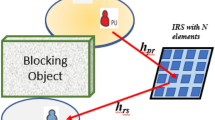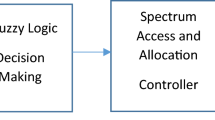Abstract
Cognitive radio networks are a promising solution to the spectrum scarcity issue. In cognitive radio networks, cooperative spectrum sensing is critical to accurately detect the existence of a primary user (PU) signal, because the local spectrum sensing by a single secondary user (SU) has low reliability. Unfortunately, cooperative spectrum sensing is vulnerable to the spectrum sensing data falsification (SSDF) attack. Specifically, a malicious user can send a falsified sensing report to mislead other (benign) SUs to make an incorrect decision on the PU activity, to cause either denial of service to benign SUs or harmful interference to PUs. Therefore, detecting the SSDF attack is extremely important for robust cooperative spectrum sensing. This paper proposes a distributed defense scheme, termed conjugate prior based SSDF detection (CoPD), to countermeasure the SSDF attack. CoPD can effectively exclude the malicious sensing reports from SSDF attackers, so that benign SUs can effectively detect the PU activity. Furthermore, CoPD can also exclude abnormal sensing reports from ill-functioned SUs. Simulation results indicate that CoPD achieves very good performance to accomplish robust cooperative spectrum sensing.







Similar content being viewed by others
References
McHenry, M. (2005). NSF spectrum occupancy measurements project summary. Shared spectrum company report.
Song, M., Xin, C., Zhao, Y., & Cheng, X. (2012). Dynamic spectrum access: From cognitive radio to network radio. IEEE Wireless Communications, 19(1), 23–29.
Akyildiz, I., Lo, B., & Balakrishnan, R. (2011). Cooperative spectrum sensing in cognitive radio networks: A survey. Physical Communication, 4(1), 40–62.
Chen, R., Park, J., & Reed, J. (2008). Defense against primary user emulation attacks in cognitive radio networks. IEEE Journal on Selected Areas in Communications, 26(1), 25–37.
Chen, C., Song, M., Xin, C., Alam, M. (2012). A robust malicious user detection scheme in cooperative spectrum sensing. In Proceedings IEEE Global Telecommunications Conference (GLOBECOM).
Yan, Q., Li, M., Jiang, T., Lou, W., Hou, Y. (2012) Vulnerability and protection for distributed consensus-based spectrum sensing in cognitive radio networks. In Proceedings 31st IEEE International Conference on Computer Communications (INFOCOM), pp. 900–908.
Chen, C.-Y., Chou, Y.-H., Chao, H.-C., & Lo, C.-H. (2012). Secure centralized spectrum sensing for cognitive radio networks. Wireless Networks, 18(6), 667–677.
Abdelhakim, M., Zhang, L. Ren, J. & Li, T. (2011). Cooperative sensing in cognitive networks under malicious attack. InProceedings IEEE International Conference on Acoustics, Speech and Signal Processing (ICASSP), pp. 3004–3007.
Min, A., Shin, K., & Hu, X. (2011). Secure cooperative sensing in IEEE 802.22 WRANs using shadow fading correlation. IEEE Transactions on Mobile Computing, 10(10), 1434–1447.
Kaligineedi, P., Khabbazian, M., & Bhargava, V. (2010). Malicious user detection in a cognitive radio cooperative sensing system. IEEE Transactions on Wireless Communications, 9(8), 2488–2497.
Kaligineedi, P., Khabbazian, M. & Bhargava, V. (2008). Secure cooperative sensing techniques for cognitive radio systems. In Proceedings IEEE International Conference on Communications (ICC), pp. 3406–3410.
Wang, W., Li, H., Sun, Y. & Han, Z. (2009). CatchIt: Detect malicious nodes in collaborative spectrum sensing. In Proceedings IEEE Global Telecommunications Conference (GLOBECOM).
Li, H., & Han, Z. (2009). Catching attacker (s) for collaborative spectrum sensing in cognitive radio systems: An abnormality detection approach. In Proceedings 4th IEEE Symposium on New Frontiers in Dynamic Spectrum Access Networks (DySPAN), pp. 1–12.
Rawat, A. S., Anand, P., Chen, H., & Varshney, P. K. (2011). Collaborative spectrum sensing in the presence of byzantine attacks in cognitive radio networks. IEEE Transactions on Signal Processing, 59(2), 774–786.
Hyder, C.S., Grebur, B. & Xiao, L. (2012). Defense against spectrum sensing data falsification attacks in cognitive radio networks. In Security and privacy in communication networks (pp. 154–171). Springer.
Visotsky, E., Kuffner, S. & Peterson, R. (2005). On collaborative detection of TV transmissions in support of dynamic spectrum sharing. In Proceedings 1st IEEE International Symposium on New Frontiers in Dynamic Spectrum Access Networks (DySPAN), pp. 338–345.
Chen, C., Song, M. & Xin, C. (2013). A density based scheme to countermeasure spectrum sensing data falsification attacks in cognitive radio networks. In Proceedings IEEE Global Telecommunications Conference (GLOBECOM).
Acknowledgments
The research of Min Song is supported in part by NSF CAREER Award CNS-0644247 and NSF IPA Independent Research and Development (IR/D) Program. However, any opinion, finding, and conclusions or recommendations expressed in this material; are those of the author and do not necessarily reflect the views of the National Science Foundation. The research of ChunSheng Xin is supported in part by NSF under Grants CNS-1418012 and ECCS-1418013.
Author information
Authors and Affiliations
Corresponding author
Rights and permissions
About this article
Cite this article
Chen, C., Song, M. & Xin, C. CoPD: a conjugate prior based detection scheme to countermeasure spectrum sensing data falsification attacks in cognitive radio networks. Wireless Netw 20, 2521–2528 (2014). https://doi.org/10.1007/s11276-014-0758-2
Published:
Issue Date:
DOI: https://doi.org/10.1007/s11276-014-0758-2




